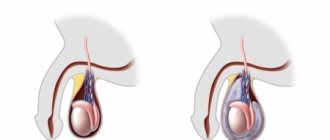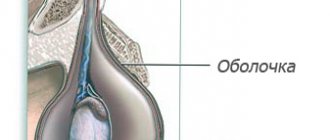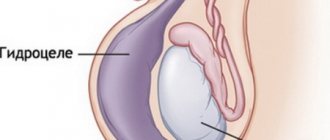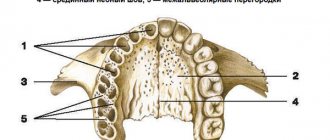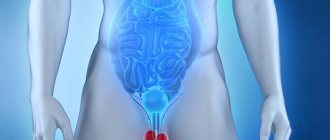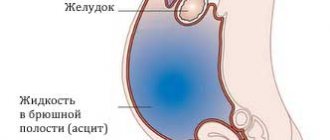Epididymitis is an inflammatory process in the epididymis. This organ is directly involved in the formation of sperm. His disease, in the absence of adequate treatment, can lead to the most serious consequences, including infertility.
Most often, epididymitis affects men and adolescents aged 15-30 years, as well as older people over 60 years of age.
In addition, the reasons for the development of epididymitis can be:
- complications after infectious mumps (so-called mumps);
- hypothermia;
- constant difficulty urinating;
- complications of tuberculosis.
Indications
Surgical treatment is indicated in the following cases:
- Abscess of the epididymis or testicle.
- Accumulation of pus.
- Lack of results from antibiotic treatment.
- Acute form of the disease.
- Infertility due to obstruction of the appendage.
Contraindications
It is not recommended to perform surgery in case of exacerbation of chronic diseases and allergic reactions to medications and painkillers.
How does epididymitis manifest?
The most common symptoms of this disease are swelling, pain and swelling of the scrotum, as well as redness on the affected side.
Ultrasound of the scrotum
- Cost: 3,000 rub.
More details
Epididymitis also manifests itself:
- the appearance of bloody impurities in the semen;
- temperature rise to 38-39 degrees Celsius;
- discomfort and pain in the groin and lower abdomen;
- pain and burning during ejaculation or during urination;
- discharge from the opening of the urethra;
- increased pain in the scrotum during movement or defecation;
What is the prevention of inflammatory diseases of the scrotal organs and their complications?
To prevent the diseases described above and their complications, you should, first of all, avoid contracting sexually transmitted infections and treat them in a timely manner, not be exposed to sudden hypothermia, and protect the scrotum from injury. You should give preference to tight-fitting panties and dress warmly in winter. If you have the above-described signs of epididymitis, orchitis and orchiepididymitis, you should urgently consult a urologist!
| Hello. Six months ago, a nagging pain arose in the scrotum. I did an ultrasound and discovered a varicocele on the left, the veins were dilated to 3.9 mm and a fluid formation of the appendage on the right was 4.2 mm. I did a prostate ultrasound - dilatation of the veins of the paroprastotic plexus on the left by 3.5 mm. The pain does not go away what should I do thanks in advance Look at other questions or ask your own on the topic: Pain in the scrotum |
Testicular anatomy
The testicle is a paired oval-shaped glandular organ that is responsible for the production of testosterone and sperm. The weight of the testicles rarely exceeds 30 grams. They are located inside the scrotum and are covered with white tissue, which visually divides the organ into 300 small parts. All parts have approximately 2-3 seminal canals. They contain Sertoli cells, which are responsible for the production of healthy sperm. Between the channels are Leydig cells, which stimulate the production of testosterone. In order for sperm to leave the testicles, it travels a long way through the efferent, convoluted, straight and accessory canals.
Severity of acute epididymitis
The transition of the pathology to the acute stage is accompanied by pronounced symptoms. There are 3 stages in total: mild, moderate, severe:
- Mild – lasts up to 3 days. An ultrasound reveals an enhanced vascular pattern, and a blood test shows an increase in leukocytes to 12,000.
- Moderate – lasts up to 6 days and has severe symptoms, including an increase in body temperature to 39 degrees Celsius and pain. Ultrasound examination reveals inflammation and hypoechoic neoplasms up to 10 mm.
- Severe – lasts more than 7 days and is accompanied by severe symptoms. A blood test shows a leukocyte count of up to 25,000, which indicates a strong inflammatory process (body temperature rises to 40 degrees Celsius). The accumulation of pus is maximum, the epididymis is significantly enlarged.
Diagnosis of inflammation of the epididymis in men
At the initial appointment, the doctor asks the patient the necessary questions, collecting anamnesis. In particular, the doctor is interested in:
- nature of complaints;
- past infectious diseases;
- injuries and operations in the scrotum area;
- sexual activity;
- presence of bad habits;
- lifestyle and working conditions.
Then the urologist-andrologist conducts:
- examination, assessing the condition of the genital organs;
- digital rectal examination of the prostate gland.
Based on the results obtained, if acute or chronic inflammation of the epididymis is suspected, the following are prescribed:
- seeding of urethral discharge on the UPM;
- culture of prostate secretion on UPM;
- PCR for urogenital infections;
- microscopy of urethral discharge;
- clinical blood test;
- Ultrasound examination of the scrotal organs. Ultrasound, being a completely safe and highly informative method, allows you to carefully study the structure of the genital organs and identify pathological processes. The additional use of Doppler makes it possible to assess blood flow, which, in particular, helps to distinguish epididymitis from testicular torsion, which has similar symptoms;
Additionally, studies such as TRUS and microscopy of prostate secretions can be performed.
After recovery, a spermogram is prescribed. Analysis of the ejaculate allows us to identify a violation of the process of spermatogenesis, as well as the presence of leukocytes and pus in the seminal fluid.
Our doctors
Perepechay Dmitry Leonidovich
Urologist, Candidate of Medical Sciences, doctor of the highest category
40 years of experience
Make an appointment
Mukhin Vitaly Borisovich
Urologist, Head of the Department of Urology, Candidate of Medical Sciences
34 years of experience
Make an appointment
Khromov Danil Vladimirovich
Urologist, Candidate of Medical Sciences, doctor of the highest category
35 years of experience
Make an appointment
Kochetov Sergey Anatolievich
Urologist, Candidate of Medical Sciences, doctor of the highest category
34 years of experience
Make an appointment
Control of cure
Acute epididymitis caused by infection is almost always completely cured if the patient takes the necessary antibiotic in the correct dose and for as long as the doctor recommends. If the disease is caused by a sexually transmitted infection, then partners should also undergo appropriate treatment.
A chronic disease must be treated for 6–8 weeks, and complete cure is not always achieved.
The urologist, as a rule, schedules a follow-up visit after 14 days to assess the effectiveness of the prescribed procedures and, if necessary, adjust the treatment. If the symptoms have not completely disappeared, additional methods of diagnosing the genitourinary system will be required.
What is the treatment for epididymitis?
A urologist deals with the elimination of pathology. In the acute stage and rising temperature, hospitalization is carried out with strict maintenance of bed rest. Locally apply cold compresses to the scrotum and fix it in its normal position. The diet is normalized, spicy and sour foods are excluded. Next, physiotherapy, antibiotics and vitamins are taken. If pus has formed, then an opening and cleaning is performed. In extreme cases, the appendage is removed to prevent the spread of infection.
Therapy for this disease should be carried out under the close supervision of a urologist. The doctors at the CELT clinic have extensive practical experience and an impressive amount of knowledge, which means they will help you get rid of this pathology in the shortest possible time.
Modern medicine uses conservative and surgical methods to treat inflammation of the epididymis. Conservative methods are relevant in the absence of suppuration and high intoxication, when the symptoms are not so pronounced. Blockage of the seminiferous tubules, accumulation of pus, increased body temperature and acute pain during ejaculation are the main indications for surgery.
What is it, how does it manifest itself and why does it happen?
Epididymitis is an inflammation of the epididymis. Orchitis is inflammation of the testicle itself, and orchiepididymitis is simultaneous inflammation of the testicle and its epididymis. The testicle, epididymis and spermatic cord are also called the scrotal organs. In practice, epididymitis is most often observed, less often orchiepididymitis and even less often isolated orchitis. Also quite rare is isolated inflammation of the vas deferens, which is part of the spermatic cord - deferentitis . These inflammatory processes can be acute, chronic and recurrent.
Acute epididymitis, orchiepididymitis or orchitis is a sudden inflammation, accompanied by enlargement and hardening of the testicle and/or its epididymis, sharp and intense pain and a rise in body temperature. With proper treatment, these diseases disappear within 2 weeks.
Chronic inflammation of the testicle and/or epididymis is characterized by a long-term (from several months to several years) course and resistance to treatment. Tuberculous epididymitis most often has a chronic course. Recurrent inflammation of the scrotal organs is associated with inadequate treatment or repeated infection in the epididymis and testicle. Chronic and recurrent epididymitis, orchiepididymitis and orchitis are manifested by a less pronounced increase and more local compaction of the scrotal organs, the pain is less intense and paroxysmal in nature, body temperature is usually normal.
The causes of these inflammatory processes are most often infections that enter the epididymis through the vas deferens from the urethra (urethra). Moreover, in young men under 35 years of age, these are most often sexually transmitted infections. In particular, chlamydia is the cause of acute epididymitis in young men with a frequency of more than 50%. At older ages (after 50 years), the leading cause of inflammation of the scrotal organs is intestinal microorganisms that cause urinary tract infections (cystitis, pyelonephritis). These include Escherichia coli, Klebsiella, Enterococcus, Pseudomonas, Proteus, etc. Less commonly, the cause of epididymitis and orchitis, as well as deferentitis, can be a tuberculosis or viral infection. Thus, in boys under 15 years of age, orchitis can often become a complication of viral mumps (mumps) or rubella. The development of epididymitis, orchitis and orchiepididymitis is greatly facilitated by sudden hypothermia, which leads to a deterioration in the blood supply to the scrotum. Inflammation of the scrotal organs can also be caused by injuries and operations on the testicle, its epididymis and spermatic cord. In this regard, after injuries to the scrotum and operations on its organs, antibiotics and anti-inflammatory drugs are often prescribed.
Conservative treatment of acute and chronic epididymitis
Therapeutic treatment is prescribed if:
- There are no accumulations of pus.
- There is no exacerbation of pathology.
- No hematomas formed.
- Tests reveal mild or moderate stage of epididymitis.
The duration of treatment is from 1 to 4 weeks, depending on the infection or virus that triggered the development of the disease. The specialist performs tests for reaction to antibiotics, after which he selects a drug based on the client’s individual characteristics. 2 antibiotics or antimicrobial drugs may be prescribed at once for synergy and better results.
Surgical treatment of acute and chronic epididymitis
Lack of results with conservative treatment and severe stage of epididymitis are the main indications for surgical intervention. There are 5 types of operations:
- Orchiectomy is the complete removal of the testicle and epididymis in the most severe cases.
- Epididymectomy - removal of the inflamed appendage.
- Puncture from the scrotum - allows you to normalize the pressure in the scrotum and eliminate pain.
- Partial resection of the appendage – resection of an area with a large accumulation of pus.
- Incision - opening microabscesses and cleaning the appendage.
The choice of surgical treatment is made by the attending physician based on the medical history and data obtained during diagnosis.
Infertility after epididymitis
- The secretory function of the appendage is impaired. Normally, epididymal secretions help increase sperm activity.
- The function of the epididymis is disrupted, which is to create conditions for the maturation of male germ cells during their interaction with the epididymal epithelium and plasma.
- The inflammatory process causes a toxic effect on the epitheliospermatogenic layer of the seminiferous tubules (spermatogenic epithelium), resulting in obstruction of the vas deferens.
- The hemotextile barrier is disrupted, resulting in the formation of ASAT (antisperm antibodies) against one’s own germ cells.
Our services
The administration of CELT JSC regularly updates the price list posted on the clinic’s website. However, in order to avoid possible misunderstandings, we ask you to clarify the cost of services by phone: +7
| Service name | Price in rubles |
| Appointment with a surgical doctor (primary, for complex programs) | 3 000 |
| Ultrasound of the scrotum | 3 000 |
| Duplex scanning of scrotal vessels | 3 500 |
All services
Make an appointment through the application or by calling +7 +7 We work every day:
- Monday—Friday: 8.00—20.00
- Saturday: 8.00–18.00
- Sunday is a day off
The nearest metro and MCC stations to the clinic:
- Highway of Enthusiasts or Perovo
- Partisan
- Enthusiast Highway
Driving directions
